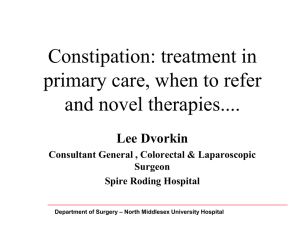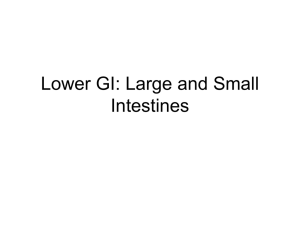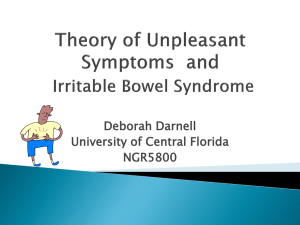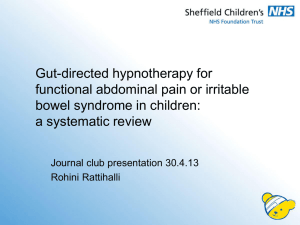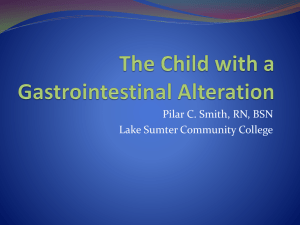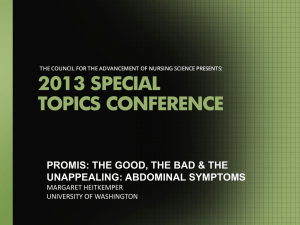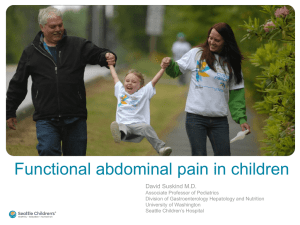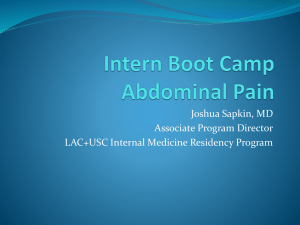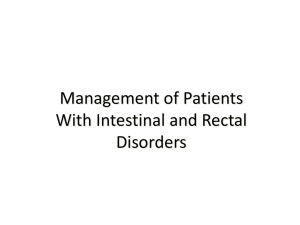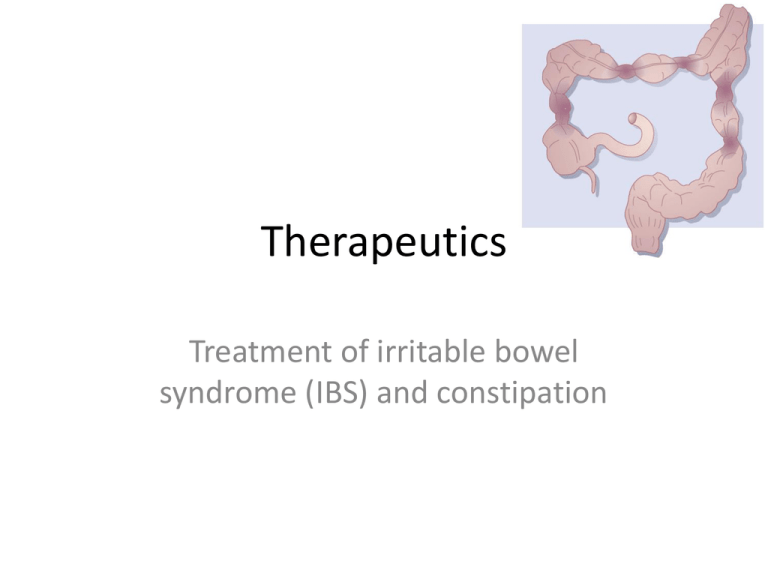
Therapeutics
Treatment of irritable bowel
syndrome (IBS) and constipation
Definition
IBS is an idiopathic chronic relapsing disorder
characterized by:
1) Abdominal discomfort (pain), bloating or
distension
2) Alteration in bowel habits (diarrhea,
constipation or both)
•
Abdominal pain / discomfort
•
Bloating / distension
•
Change in bowel habit
Alarm features = investigations
1.
2.
3.
4.
5.
6.
7.
8.
9.
Predominant constipation
age older than 50 years
symptom duration less than 6 months
weight loss
nocturnal symptoms
family history of colon cancer
rectal bleeding
Anemia
recent antibiotic usage.
K
Treatment of IBS
Aims of treatment:
1) Relieve abdominal pain and discomfort:
1. Anticholinergic drugs (commonly used are; dicyclomine and
hyoscyamine) MOA: block M receptors
2. Low doses of TCA (e.g. amitriptyline or desipramine). Low
doses have no effect on mood.
2) Relieve distension / bloating
3) Improve bowel function
1. For patients with predominant diarrhea: anti-diarrheal agents
(especially loperamide) and serotonin 5-HT₃-receptor
antagonists
2. For patients with predominant constipation: laxatives (bulkforming or osmotic laxatives especially Mg oxide) and
serotonin 5-HT₄-receptor agonist
Antispasmodic drugs in IBS
Action: relieve smooth muscle spasm →relieve pain and bloating in IBS)
1. Anticholinergic drugs:
Mechanism of action:
Block muscarinic receptors (M₃ on smooth muscles in case of
hyoscine or presynaptic M₁ in case of dicyclomine)
Adverse effects:
1. Blurred vision (may lead to glaucoma)
2. Dry mouth
3. Tachycardia
4. Urinary retention
5. Constipation
6. Heat intolerance
7. Confusion
Antispasmodic drugs in IBS
Contraindications of anticholinergic drugs
1. Patients with glaucoma
2. Prostatic hyperplasia (elderly)
Drug interactions of anticholinergic drugs:
1. With other drugs having anticholinergic
effects
Antispasmodic drugs in IBS
2. Mebeverine: (less effective than anticholinergic drugs)
Mechanism of action:
Not known (? calcium channel blocker or ?
Direct acting)
Adverse effects:
1. Hypersensitivity reactions
2. In high doses: anticholinergic side effects
Antispasmodic drugs in IBS
(for bloating/pain)
Anticholinergic drugs
Hyoscine or dicyclomine
Mebeverine
-
Indications:
1. Female or young male patients (no
prostatic enlargement)
2. IBS with predominant diarrhea
3. Symptoms of pain or bloating
Indications:
1. Symptoms of pain or bloating
2. IBS with predominant diarrhea or
predominant constipation
Contraindications:
1. Glaucoma
2. Prostatic enlargement
Contraindications:
1. Hypersensitivity to the drug
Which antispasmodic is preferred in patients with IBS with predominant constipation?
Which antispasmodic is indicated in patients with IBS with glaucoma or prostatic enlargement?
Tricyclic antidepressants
Action: relieve pain and bloating in IBS
Mechanism of action:
Block synaptic amine uptake (both
norepinephrine and serotonin) →↑ presence
of serotonin and norepinephrine at their
post-synaptic receptors (→ anxiety) followed
by down regulation of the receptors
→(delayed anxiolytic and antidepressant
effect)
Tricyclic antidepressants
Drugs:
Amitriptyline or Desipramine (10 – 50 mg/d) . (N.B. the
usual antidepressant dose = 75 – 200 mg)
Adverse effects:
1. Blurred vision
2. Dry mouth
3. Constipation
4. Retention of urine
5. Orthostatic hypotension
6. Arrhythmia
7. Cardiac conduction disturbances
Tricyclic antidepressants
Contraindications:
Glaucoma
Elderly patients
Patients with cardiac diseases
Selective Serotonin Reuptake Inhibitors (SSRI)
Mechanism of action:
Selective block of synaptic uptake of serotonin.
Drugs:
Cetalopram (less P450 inhibition → less drug interactions)
Adverse effects:
Mainly GIT including:
1. Nausea and vomiting
2. Diarrhea or constipation
3. Anorexia and weight loss
4. Sexual dysfunction
Laxatives
Classification:
1. Bulk-forming
2. Osmotic laxatives
3. Stimulant laxatives
4. Fecal softeners / emollients (little role in
chronic constipation)
Laxatives
1. Bulk-forming laxatives:
Containing more soluble
fibers (more flatulence)
1. Methylcellulose
2. Psyllium
Containing more insoluble
fibers (less flatulence)
1. Bran
Precautions:
Adequate fluid intake to avoid intestinal obstruction
Adverse effects:
1. Abdominal distension (due to fermentation).
2. Intestinal obstruction when not consumed with
sufficient fluid
Laxatives
2. Osmotic laxatives:
a. Saline laxatives (e.g. Mg oxide)
b. Non-digestible sugars or alcohols (e.g. lactulose)
c. Polyethylene glycol
d. Glycerin
Mg oxide is preferred because it is less expensive and it
causes less distension
Adverse effects of Mg oxide:
1. Flatulence, abdominal cramps, diarrhea
2. Intravascular volume depletion
3. Electrolyte disturbances
Laxatives
Contraindications of Mg oxide
1.Renal insufficiency
2.Severe cardiac disease
3.Preexisting electrolyte abnormalities
4.Patients on diuretic therapy
Treatment of diarrhea:
Antimotility agents (opioids)
Opioids agonists:
Action in the GIT (mediated by binding to opioid receptors)
1. Increase segmentation and a decrease propulsive
movement → ↑ intestinal transit time → ↑ absorption
of water and electrolyte → feces become more solid
2. Antisecretory
3. ↑ tone of the internal anal sphincter
4. ↓ response to the stimulus of a full rectum (by their
central action)
Antimotility agents (cont)
Mechanism of opioid action:
Inhibition of presynaptic cholinergic nerves in
the submucosal and myenteric plexuses
Opioiods - Diphenoxylate
Opioid agonist that has no analgesic properties in
standard doses. Higher doses have central opioid
actions. Used in combination with a sub-therapeutic
dose of atropine (to prevent abuse)
Contraindications:
1. Children below 2 y (toxicity at lower doses than
adults)
2. Obstructive jaundice
Opioiods - Diphenoxylate
Drug interactions:
1. Potentiate the effects of CNS depressants
2. Co-administration with MAO inhibitors→
hypertensive crises
Adverse effects:
1. Caused by the atropine in the preparation and
include anorexia, nausea, pruritus, dizziness, and
numbness of the extremities.
2. Prolonged use of high doses may cause
dependence
Opioids - Loperamide
Opioid agonist that does not cross the bloodbrain barrier and has no analgesic properties
and no potential for addiction
Adverse effects:
Abdominal pain and distention, constipation,
dry mouth, hypersensitivity, and nausea and
vomiting.
Role of 5HT₃ and 5HT₄ receptors in GIT motility
GIT distension → stimulate EC cells in the mucosa of the intestine → release of 5HT →
Binding of 5HT to
5HT₄R →
↑ release of
ACH and CGRP
5HT₃R are found on terminals of enteric
cholinergic neurons → ↑release of ACh
5HT₄R
Ach
CGRP
5HT
5HT₁pR
Submucosal intrinsic
primary afferent neuron
(IPAN)
2nd order enteric
cholinergic
neuron
↑Proximal bowel contraction
↑ Distal bowel relaxation
5HT₃R
→ CNS
5HT
Extrinsic afferent nerve
→ stimulation of
nausea, vomiting
and abdominal pain
Serotonin 5HT₃ receptor antagonists
1. Inhibition of 5HT₃ receptors in the GIT→
inhibit nausea, bloating and pain
2. Inhibition of 5HT₃ receptors in the brain→
inhibit central response to afferent visceral
stimuli
3. Inhibition of 5HT₃ receptors on terminals of
enteric cholinergic neurons → ↓motility in
the left colon and ↑colon transit time
Serotonin 5HT₃ receptor antagonists
Alosetron
Action: relieves lower abdominal pain, urgency
and diarrhea (no effect on stomach)
Mechanism of action: 5HT₃ receptor antagonist
Uses: Female patients with severe IBS with
diarrhea with no response to other therapies
Serotonin 5HT₃ receptor antagonists
Alosetron
Pharmacokinetics:
Rapidly absorbed after oral administration
Plasma t½ = 1.5 h.
Long duration of action (dissociates slowly from
5HT₃ receptor)
Extensive hepatic metabolism (P450) with renal
excretion of metabolites
Adverse effects:
Constipation
Ischemic colitis (may be fatal)
Serotonin 5HT₄ receptor partial agonist:
Tegaserod
Action:
1. ↑gastric emptying and enhance small and large bowel
transit (no effect on esophagus)
2. ↑ stool liquidity
Mechanism of action of tegaserod:
Serotonin 5HT₄ partial agonist. Binding to 5HT₄ receptors on
the terminals of the 2nd order enteric neuron
→↑ release of Ach and CGRP →
↑gastric emptying and enhance small and large bowel
transit (no effect on esophagus)
→↑ Cl secretion from the colon →↑ stool liquidity
Tegaserod
Pharmacokinetics:
Low bioavailability (further reduced by food)→
should be taken before meals
Metabolized in liver (by glucuronidation)
Excreted in feces (unchanged) and in urine
(metabolites)
Contraindications:
Severe renal or hepatic impairment
Tegaserod
Uses:
Short term treatment (up to 12 weeks) of women with
moderate/severe IBS with predominant constipation who
have failed to fiber supplementation and laxatives (reduce
pain and bloating - ↑ bowel movements and ↓ hardness
of stools)
Other uses:
Chronic constipation in patients not responsive or intolerant
to other less expensive therapies
Adverse reactions (rare):
1. Diarrhea
2. Headache
Summary of treatment of IBS with predominant constipation
Diet
High fiber diet (soluble fiber as in fruits and vegetables is better
than insoluble fiber in cereals and bran)
Constipation
1. Bulk-forming laxatives such as methylcellulose (contain more
soluble fiber) + increase water intake. → improve
constipation. What is the effect on abdominal pain?
2. If no effect: give osmotic laxatives (Mg oxide is preferred to
Lactulose (cheaper and causes less abdominal distension)
3. If no effect: give 5HT₄ agonist (Tegaserod)
Pain
1. Antispasmodics (mebeverine is preferred. Why?)
2. If no effect: give antidepressants. (SSRI drugs as Cetalopram
are preferred. Why?)
Bloating with
distension
1. Probiotics
2. If no effect: give 5HT₄ agonist (Tegaserod)
Bloating without
distension
1. Probiotics
2. Tricyclic antidepressants
Summary of treatment of IBS with predominant diarrhea
Diet
Avoid excess carbohydrates and dairy products
Treatment of
diarrhea
1. Antimotility agents as Diphenoxylate or Loperamide.
(Loperamide is preferred. Why?) - What is the effect on
abdominal pain?
2. If no effect: give 5HT₃ antagonist (Alosetron)
Treatment of pain 1. Antispasmodics (anticholinergic drugs are preferred. Why?
2. If no effect: give antidepressants. (Tricyclic antidepressant
drugs as Imipramine are preferred. Why?)
Bloating with
distension
1. Probiotics
2. If no effect: give 5HT₄ agonist (Tegaserod)
Bloating without
distension
1. Probiotics
2. Tricyclic antidepressants
Case (1)
A 34-year-old woman presents with a 6-month
history of abdominal pain, bloating, distension,
decrease in the number of bowel movements per
week (<3 times) and difficulty when passing
stools. She also states that the abdominal pain
and bloating almost occur continuously
throughout the day although her symptoms are
alleviated by passing stool. She also states that
the symptoms are worse when she has midterm
or final examinations.
Case (1) cont.
She was taking bran till 3 months ago but could not
stand the taste and wasn’t sure how much it was
helping. She switched to psyllium powder but she
felt that distension increased. She was also
treated with sorbitol solution but it has some side
effects and she resumed taking psyllium again.
Medical examination and investigations were
unremarkable apart from slight abdominal
distension and slight tenderness over the lower
abdomen.
Case (1) Questions
1. Why did Psyllium caused abdominal
distension?
2. What are the most probable side effects of
lactulose in this patient?
3. Mention the drugs required for the patient?
4. What are the side effects of each drug
prescribed?
Case (1) answer
A case of IBS with:
1. Predominant constipation
2. Abdominal pain
3. Bloating
Case (1) answer
Psyllium increased abdominal distension
because it contain insoluble fiber which is
fermented by colonic bacteria.
Side effects of lactulose:
1. Diarrhea
2. Abdominal distension
3. Taste may be objectionable
Case (1) answer
Treatment:
1. Diet:
High fiber diet consisting mainly of fruits and vegetables
2. Laxatives:
Bulk-forming laxatives such as methylcellulose with
increasing drinking of water
3. Antispasmodics:
Mebeverine or Hyoscine (Mebeverine is preferred
because Hyoscine may increase constipation)
4. Probiotics
5. Tegaserod
Case (2)
• A 40-year-old man presents for the evaluation of
abdominal pain and diarrhea. He states that for about 8
months he has had progressively worsening cramping
pains, bloating and diarrhea (3 times/day). with loose
stools. However, stools never contained blood. He has tried
over-the-counter antidiarrheal medications but diarrhea
often recurs. He is on no medication regularly and has no
significant medical history. Examination of his abdomen
revealed it to be distended and diffusely tender with no
palpable masses. Otherwise, the patient is normal.
• What medications could be prescribed to that patient.
What are their side effects? Comment on the diet that
should be followed by the patient.
Case (2) Answer
Diet:
Diet should be low in carbohydrates
Drugs:
The patient had IBS with predominant diarrhea
with pain and distension.
Treatment of diarrhea: Loperamide. (why not
diphenoxylate?) What can you prescribe if
loperamide fails? What are the side effects of
the new drug? (see the table)
Case (2) Answer
Treatment of abdominal pain:
1. Antispasmodics as Hyoscine (what are its side
effects and contraindications?). Why
hyoscine is preferred to mebeverine in cases
of diarrhea?
2. What are the second line drug you can
prescribe if Hyoscine fails? What are the side
effects of the new drug? (see the table)
Case (2) Answer
Treatment of bloating:
Probiotics. (why tegaserod could not be
prescribed in this case?)
Treatment of constipation
Acute constipation
1. Glycerine suppository
If not effective:
1. Oral sorbitol or lactulose or saline laxatives
(e.g., Mg hydroxide)
2. Low doses of bisacodyl or senna or cascara
Treatment of constipation
Chronic constipation:
1. Dietary modifications that increase dietary
fiber
2. Bulk-forming agents (daily and continued
indefinitely)
Treatment of constipation in special
populations
Bed ridden, geriatric or chronic constipation patients:
1. First line of treatment is bulk forming laxatives
2. Second line: more potent agents may be required :
a) Osmotic laxatives (Saline laxatives as Mg hydroxide) or
poorly absorbed sugars (sorbitol or lactulose).
b) Irritant laxatives (bisacodyl, senna, cascara)
• Mineral oil should be avoided, particularly in bed-ridden
patients. Why? (because of the risk of aspiration and lipoid
pneumonia).
• When other than bulk-forming laxatives are used, they
should be administered in the lowest effective dose and as
infrequently as possible to maintain regular bowel function
(more than 3 stools per week).
Treatment of constipation in special
populations
Fecal impaction.
Before oral laxatives can be used, the impaction
needs to be removed using mechanical
methods, including tap-water or saline
enemas and digital extraction.
Treatment of constipation in special
populations
In the hospitalized patient without GI disease:
1. If rapid bowel evacuation is required:
Either
a)glycerin suppository or
b)oral Mg hydroxide
Followed by: 2.
2. Most orally or rectally administered laxatives
may be used in these situations.
Prevention of constipation
1. Prevention of straining during recovery from
myocardial infarction or following rectal
surgery
2. During pregnancy
1. Bulk-forming laxatives
2. Docusate
3. Irritant laxatives (mentioned
in some books)
Other uses of laxatives:
Evacuation of bowel before surgery or diagnostic procedures
involving the GIT as sigmoidoscopy or barium enema:
Oral forms:
Oral bisacodyl, sodium picosulfate, cascara or senna (active after 6 -12
h) Given the night before operation or procedure)
Oral castor oil (active after 1-3 h)
Oral Mg hydroxide (active after 2-5h)
Rectal suppository:
Bisacodyl rectal suppository (active after 30 – 60 min)
Enema:
Rectal Na sulfate enema (active after 30 min)
Polyethylene glycol - electrolyte solution enema
Case (1)
A 35-year-old patient on normal diet and
exercise presented with Constipation since 2
weeks. Mention three alternative drugs from
different groups that could be used to treat his
condition giving the side effect of each.
Answer:
1. Glycerine suppository
2. Lactulose
3. Bisacodyl
Case (2)
You have been asked to prescribe a drug for
prevention of straining for a hospitalized
patient treated from myocardial infarction.
Mention 2 drugs from 2 different groups
giving their side effects.
Case (3)
A patient will undergo sigmoidoscopy in the
next morning. Mention drugs which could be
given to evacuate his bowel giving the
expected time of action and possible adverse
effects.
Constipation questions
Mention two pharmacological groups of drug
that may cause constipation as a side effect
giving the mechanism in each case.
To which category of drugs does lactulose
belong? Comment on its mechanism of
action.
Comment on the adverse effects which are
associated with the use of stimulant
laxatives.

